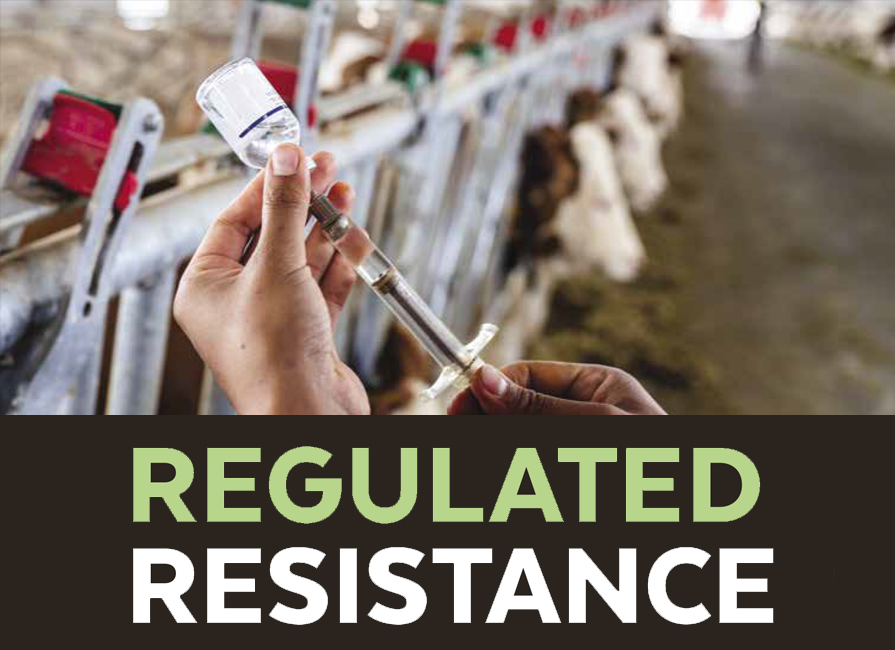One of the key attractions of our Certified Regenerative by AGW program is its practical…

Regulated Resistance
“Eureka!”
In 1928, a bit of mold drifted through a lab window and into a petri dish. Scientist Alexander Fleming noticed a “dead zone” forming where the mold inhibited bacterial growth and, as the story goes, realized in a “eureka!” moment that the mold could be used to treat infection.
Miracle drugs
In the century that followed, antibiotics have transformed medicine. Mass production of penicillin during World War II saved countless lives, and various classes of antibiotics have since been developed to combat serious infections. Surgery is safer because these drugs prevent post-operative infections. Once-debilitating childhood illnesses like strep throat and ear infections are now easily treatable. Organ transplants and cancer treatments have advanced because antibiotics prevent and treat infections in immunocompromised patients. Access to over-the-counter (OTC) antibiotics for livestock has given farmers the ability to promptly address bacterial infections without calling a veterinarian. For livestock, this has often led to quicker treatment, reduced spread, and improved animal health.
Germ warfare
Unfortunately, the bacteria were not willing to let Fleming have the last word. When exposed to antimicrobial drugs, surviving bacteria adapt to withstand the effects of antibiotics. Bacteria can pass on those resistance traits not only to their offspring, but also to their peers—and even to other species of bacteria.
Widespread antimicrobial resistance has led to longer and more severe illnesses, increased mortality rates, higher healthcare costs due to prolonged treatments or hospitalizations, and the emergence of infections that are difficult or impossible to treat. Infections that were once easily cured with antibiotics, like pneumonia or urinary tract infections, can now become life-threatening if antibiotic resistance develops. Antimicrobial resistance has also made routine medical procedures such as surgeries, chemotherapy, and organ transplants riskier.
Resistance rising
Without veterinary oversight, misdiagnosis and incorrect treatment of livestock occur more often, increasing the number of bacteria that acquire resistance. Unfortunately, easy access to OTC antibiotics for livestock has contributed to this significant global public health threat. In 2023, nearly 100 years after their discovery, many livestock antibiotics in the U.S. switched from OTC to prescription-only.
While a handful of medications not considered critical to human health have remained OTC, penicillins (including many mastitis tubes), oxytetracyclines, and sulfa antibiotics are a few examples of drugs that are no longer available without a prescription. While the new rules were implemented to protect public health, they also present some challenges for U.S. farmers. How can we continue to safeguard animal health, as synthetic antimicrobials become more costly and less accessible?
Key actions
Here are some key actions you can take to keep your animals healthy under the new rules:
- Establish relationships: Develop strong relationships with veterinarians to ensure timely diagnosis and treatment, including prescription antibiotics when indicated. If possible, establish a written Veterinary-Client-Patient Relationship (see left). Collaborate with your community of livestock experts, including extension and other producers, to identify sustainable and effective management strategies that fit your operation.
- Choose healthy genetics: Select breeders that demonstrate disease resistance and resilience. Determine which animals respond well to alternative treatments.
- Promote health: Ensure excellent nutrition, appropriate facilities, and low-stress handling. Maintain good animal hygiene. Consider probiotics and prebiotics.
- Monitor animal health: Know your herd’s ‘normals’ and assess animals regularly to facilitate early detection of disease. Act promptly when response to alternative treatments is best.
- Manage housing: Provide proper ventilation, clean bedding, and adequate light. Maintain walkways, feeders, and loafing areas to facilitate safe, stress-free animal movement and utilization.
- Prevent disease: Vaccinate as indicated and ensure good sanitation. Explore alternative veterinary interventions to prevent and mitigate disease.
- Practice biosecurity: Take steps to prevent the introduction and spread of diseases.
- Keep records: Maintain detailed records of animal health, treatments, and outcomes. Use records to identify high-impact health management practices, and to facilitate accurate diagnosis and treatment decisions.
- Keep current: Stay informed about best practices in animal health through industry publications, extension, and other educational offerings.
Improving conditions such as nutrition, housing, and cleanliness often reduces the impact of disease, which means less is spent on veterinary consultations, medications, and labor associated with treating sick animals. Less treatment also means less handling stress, facilitating better immune function.
Be prepared
Use of antibiotics in livestock contributes to antibiotic resistance, as well as consumer concerns about animal welfare and food safety. Using fewer antibiotics helps minimize the risk of antibiotic-resistant bacteria and also encourages more sustainable and holistic approaches to animal health. Reduced reliance on pharmaceuticals can lead to better management practices, focusing on preventive measures, improved conditions, and overall health. Veterinary oversight helps mitigate risks and promotes more responsible antibiotic use.
Sir Alexander Fleming was quick to remind people, “I did not invent penicillin. Nature did that. I only discovered it by accident.” And yet, as the famous discoverer of microbial ‘germs’ Louis Pasteur famously stated, “Chance favors the prepared mind.”
In livestock husbandry as in science, nature favors those who are prepared. When it comes to working with the new antibiotic rules, that means keeping in touch with animal health experts while implementing sound preventive and health management practices. If you keep notes on your own on-farm management experiments, perhaps you too will have some “Eureka!” moments, as sound observations and good recordkeeping show that promoting health with less antibiotics is a self-perpetuating cycle.
VCPR
A veterinarian-client-patient relationship (VCPR) is a working relationship between a veterinarian and a client. A written agreement may be useful, but the core requirement is that the vet has examined the animals as recently and as thoroughly as needed to ethically diagnose and treat. It is illegal for a veterinarian to write a prescription without a current VCPR.
Author: Jennifer Gravley DVM is a veterinarian and educator with a special interest in the intersection of food animal medicine and public health
Originally published in the Summer 2024 issue of AGW’s Sustainable Farming magazine.


